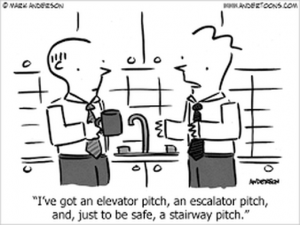Imagine you find yourself face-to-face with the hiring manager for your dream job.
You have the length of an elevator ride to introduce yourself and convince them to consider you for the position.
Would you stutter, say a lot of filler words, and possibly lose your chance to make a good impression? It’s probably best to not risk it, so I recommend spending some time crafting an elevator pitch.
Your pitch is an important part of your candidate portfolio, but it’s one that often gets overlooked by job seekers. One reason is probably because an elevator pitch feels pretty awkward, especially if you don’t have a background in sales.
In the United States, it’s considered rude and impolite to brag or boast about one’s accomplishments or skills. So, the thought of compressing our professional lives down into one 30-second paragraph, that’s supposed to make someone want to hire us, can be pretty unnatural and uncomfortable.
This is why you don’t want to craft your elevator pitch like your resume. Your resume is a factual document that should showcase your skills and accomplishments in “third person” language, and would sound unusual as a pitch in American culture.
The use of the “professional voice” is another tool that works very well on your resume, but not so much in your elevator pitch. Your resume is most often read silently, and not usually vocalized. Because it is a document, and not a conversation, the “professional voice” is appropriate and quite effective on your resume, but not in your pitch.
Here is a version of the Professional Profile from my resume:
Knowledgeable and accomplished professional with several years’ experience in the Career Services field and a history of success creating professional, eye-catching, and effective resumes for adults in specialized career fields.
Sales and Marketing | Accounting and Finance | Entrepreneurs | Newly Relocated | Career Transitions | Returning to Workforce | Service Industry | Engineering | Students | Educators | Band Directors | Musicians
An elevator pitch, on the other hand, is a face-to-face conversation with someone, so it needs to feel and sound much more casual and natural.
The most effective way I’ve found to craft an elevator pitch is to focus more on what my passions are, as they relate to my current (or intended) career.
Most hiring managers know that if an employee is truly passionate about what they do, they will also work hard in order to be great at it. Showing passion for your craft is a great way to convey your value within your field.
So, here is an example of what my elevator pitch might look like:
“My passion in life is helping others. I have a background in education, and I have always loved watching someone “get” a new concept or learn a new skill. I spent a lot of time early on in my career trying to figure out what I wanted to “do when I grow up.” This meant a fair amount of job hopping and career transitions – but that is exactly what led me to finding the career I love today. Sharing new knowledge with my clients that will help them be successful in furthering their careers – and that will continue to help them as they move into the future – is hugely rewarding to me, and it makes me happy every day.”
Did you notice the difference between my Professional Profile and what I might say to someone in a face-to-face conversation? Some of the profile details remain, but the language is much more conversational.
The main idea of the pitch is to summarize who you are, what you do and how you’re good at it, while remaining personable, so it doesn’t sound like you’re just spouting your resume.
Also, once your pitch has been memorized, be sure to practice it on trusted friends/family/colleagues. Some things sound better in writing, and you’ll want to revise anything that comes across as awkward or confusing.
Timing is important too. Because you practice and memorize your pitch, it is easy to rush through it, especially if your heart is racing. If you’re having trouble with timing, use the 150 words per minute guideline.
And, because more planning is better, creating a few different versions of your pitch will help in situations where you may have more or less time to get your points across.
Good luck out there!
Want more career-related goodness?
- Get a powerful 5-Step Resume Action Plan that will help you transform your resume into an interview-getting machine.
- Download my 54 Super Impressive Resume Action Verbs list by joining the Career Courage Facebook group.
- Find more DIY career resources here.
- Apply now for a free strategy call if you’re thinking about 1:1 services with a career expert.


